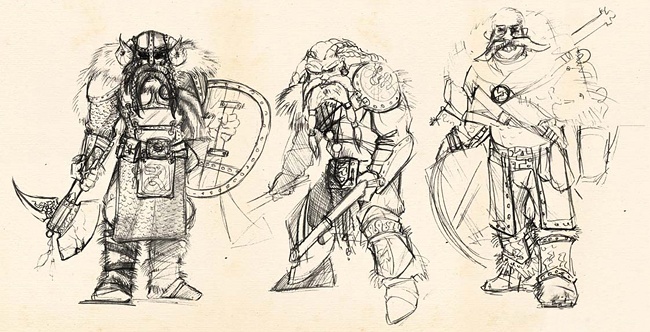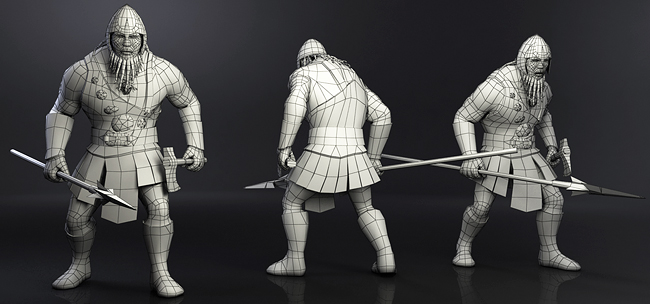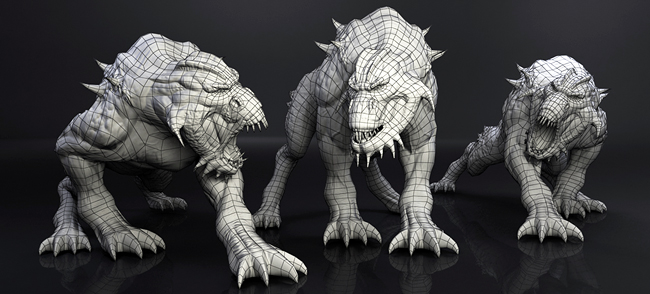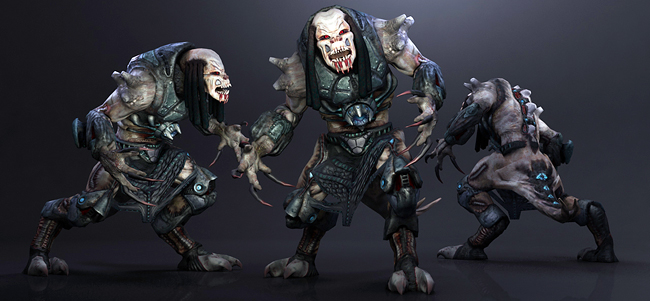For most people outside 3D industry 3D modeling appeared 20 years ago when Jurassic Park with its computer generated creatures came out. But we all know that 3D modeling and animation have a long history and was first used many decades ago to create fantasy creatures, characters and objects for animated and real-life motion pictures.
Production of 3D assets for different sectors including films, games, TV, web, marketing, architecture, education, government, medicine, etc, has taken pride of place among related fields and being a 3D artist is now a recognized career, however it requires definite set of skills and knowledge and knowing one 3D modeling tool is often not enough to create awesome 3D character or animation.
Utilizing all spectrum of features offered by advanced 3D modeling software can be redundant and confusing so select only few of them and follow my tips and advices to learn how to benefit from subdivision modeling technique, voxel-based software tools, normal maps, retopology tools and a whole range of other features and tools.
Improve your drawing skills
Being an organic modeler requires proper understanding of anatomy and real-life topology. Some 3D creatures should be first drawn by hand to work out a character concept and subject anatomy and make real-time changes before starting to create a 3D model from scratch.
Many concept artists recommend making several images showing a model from different perspectives and angles to make sure all body parts and bones fit together and the final outcome is convincing enough. We recommend taking some time and learn how character bones and muscles are attached together and how quadrupeds’ skeleton is organized.

Register for anatomy class
To make one step forward and enhance life-drawing skills we recommend enrolling in the anatomy or life-drawing class and getting some practice and experience there. You can decide on self-study and search for material references in Google or some related books, and learn how certain group of bones and muscles are attached and interact with the next one. The more you get familiar with anatomy the more convincing your 3D characters and creatures will look. The most appropriate alternative is a life-drawing class arranged by large studios and companies for 3D artists and organic modelers.
Give special consideration to form and volume
No matter what modeling technique you are using, polygonal modeling or digital sculpting, the first thing you should pay attention to is the overall shape and form of a character. You need to work on your model from different angles and not to add to many details from the very beginning. The shape must be accurate from all perspectives and it is preferable to start model details from top to bottom to get the overall picture.

Edge loops and topology
If you are working on 3D animation, than you should know that edge loops and proper topology of a character are essential for rigging your model. Rigging a character has nothing to do with art and creativity; one should strictly follow some technical rules to create a convincing animation. Being a 3D modeler who uses subdivision method of modeling it is crucial to have a smooth edge flow in definite areas of a mesh. Here your anatomy skills and knowledge will come in handy as this edge flow often resembles a real-world anatomy. A vivid example of an edge loop is a muscle ring around a mouth or an eye. This ring makes an eye and a mouth open and close. Properly created edge loop enables 3D artist create good animation. But poorly created model will be impossible to rig and animate, in other words it will deform badly and will make unnatural movements once animated.
Use subdivision modeling
No matter what 3D modeling software you are using, dividing and rounding polygons is essential part of modeling, which helps to achieve more natural outcome and allows keeping the polygon count down. This technique is called a subdivision modeling and allows switching between smoothed and unsmoothed mode when modeling a 3D character.
This technique divides each polygon into four small polygons and rounds it off. You can set a higher level of subdivision to get rounder and smoother mesh. The majority of 3D modeling software tools like 3ds Max, Maya, ZBrush or Cinema 4D allows artists to subdivide mesh and then to return it to the normal level, and so refine the look and form of a model.

Model in quads, rarely use triangles and never N-gons
We strictly recommend to model in quads, rarely use triangles and avoid using N-gons. And here is why…
Most 3D artists are using quads, as they are more predictable and can cause less bad artifacts at render time. However, if you are modeling in quads you are modeling in triangles too (as each quad consists of two triangles when divided in two). What we are talking about is that you try to avoid N-gons as they can lead to unexpected problems in some software tools when divided and during rendering. N-gons can be used in some modeling cases, but you can always use quads or triangles instead of them, so better avoid N-gons.
Combine box and edge modeling
As a 3D modeler you will need to master as many modeling methods and techniques as possible. A combination of some modeling methods and techniques will open broad opportunities for creating stunning and realistic 3D assets. A combination of edge and box modeling can be necessary when modeling such elements as ears, nose or other delicate face and body parts.
Box modeling is called so because you start modeling with a simple shape (a box) and then add polygons and cuts. Edge modeling is a modeling method when you extrude or string some points together and add more geometry onto existing polygons. We recommend learning both techniques well as you will necessarily fall back on both of them.

Use DynaMesh and retopology tools
ZBrush fans can be happy of using such a handy tool for digital sculpting, as DynaMesh allows creating amazing 3D characters and creatures without leaving ZBrush for other modeling tools. This modeling process uses a subdivision modeling at the root. But subdivision modeling presupposes that pooling out a part of a model will stretch the underlying polygons too. DynaMesh method solves this problem by your model on the go. 3D artists no longer have to follow what is happening with polygons in the background, because ZBrush is doing it for you. This incredible technique called DynaMesh allows you to focus on a form and a silhouette of your model. However, DynaMesh doesn’t ignore the topology rules and here is where retopology tools come in handy.
If you created a 3D model without consideration of underlying topology you will not be able to rig and animate a character. Advanced tools such as Autodesk Maya, Modo (the Foundry), ZBrush (Pixologic), 3D-Coat (Pilgway) and others offers broad opportunities for creation of a new base (low-poly) mesh over the detailed high-poly model. And this a revolutionary feature making a modeler and animator work easier many-fold. Retopologising method is applied at the end of modeling process and is the effective tool for correct and easy character rigging and animation.
Use normal maps to add realism to your characters
Another trick allowing to create a low-poly model that will look as a highly realistic object is the use of normal maps.
As we all know, low-polygonal models are used in games and real-time applications. But even with technological progress and modern powerful CPUs and GPUs do not allow to render high-poly models at extremely fast pace and get smooth outcome. There is still a limitation on the number of polygons and number and size of textures. Normal maps allow getting a high level of detail even with limited number of polygons. To extract and apply a normal map to your mesh it is required to have UV co-ordinates. These simple actions will give your low-poly model a look of a detailed high-poly model.

But not all models can be exported for further retopology and sculpting. Only voxel-based program allows this level of flexibility.
We can name some voxel-based modeling software tools, such as 3D-Coat and Sculptris, but there are majority of other handy tools meeting specific needs. These programs allow adding triangles and sculpting the desired volume. We consider voxel-based modeling software tools to be a great to create complex forms and shapes without focusing on a model topology and edge flow.
The final outcome can be retopologised for further animation. These software tools can become a great addition to your software modeling pack and it is definitely worth time spent on learning it.
As a 3D modeling studio, we have vast experience in creating 3D characters for games, films, advertising, virtual trainings, etc. Go to our portfolio for more organic modeling samples and to see how we rig our characters for animation.









